The following has been developed to communicate hazard and safety information about hazardous substances to employees and to comply with Cal/OSHA requirements (8 CCR Section 5194). Key elements of this program include:
- Hazard identification
- Training and communication
- Labels
- Safety Data Sheets (SDSs)
Download the Hazard Communication Implementation Plan.
Download the Hazard Communication Handout.
The purpose of the Hazard Communication Program is to provide for and support methods for informing employees about hazardous substances they may be exposed to in the workplace, including potential harmful effects and appropriate control measures.
Covered employees, operations, and substances
This program applies to:
- All non-research University employees
- Laboratories that primarily provide quality control analyses for manufacturing processes, or that produce hazardous substances for commercial purposes
- Hazardous substances purchased and used by Stanford employees for non-research uses
Exempted or partially exempted operations and substances
The following operations are exempted or partially exempted from this program:
Research laboratory operations
Research laboratory operations are exempted from the provisions of the Hazard Communication Program and are addressed under the Stanford University Chemical Hygiene Plan (CHP). Research laboratory operations shall:
- Ensure that labels are not removed or defaced (see the Safety Data Sheets tab)
- Maintain SDSs and ensure that SDSs are available to employees (see the Hazardous Chemical Inventory tab)
See the Stanford University Chemical Hygiene Plan for specific requirements affecting laboratory employees.
Warehouse operations
Warehouse operations where chemicals are only handled in sealed containers are exempted from the provisions of the Hazard Communication Program. Such operations include:
- Warehouses
- Stockrooms
- Shipping/receiving
These warehouse operations shall:
- Ensure that labels are not removed or defaced (see the Safety Data Sheets tab)
- Maintain SDSs and ensure that SDSs are available to employees (see the Hazardous Chemical Inventory tab)
- Provide hazard communication training (EHS-4300) and job-specific hazard communication training to employees
Exempted substances
The following substances are exempt from the requirements of this program:
- Hazardous waste
- Tobacco or tobacco products
- Wood or wood products, including lumber, if it will not be processed and the only hazard it poses to employees is the potential for flammability or combustibility
- Articles (see definition in the glossary)
- Food, drugs, or cosmetics intended for personal use
- Consumer products used in the workplace, when used normally (e.g. White-Out or spray paint used for short, one-time applications)
To ensure safe use, handling, and storage, personnel must be aware of the associated hazards before using hazardous substances.
Supervisors
Supervisors are responsible for implementing the Hazard Communication Program at the local operational level. Supervisors must ensure the safe use of hazardous substances in all areas under their supervision. This includes:
- Identify hazardous substances in the work area and potential hazards related to their use
- Ensuring that hazardous substances are appropriately labeled or posted
- Ensuring that pipes carrying hazardous substances are labeled
- Obtaining SDSs for hazardous substances used in the work area, and ensuring that SDSs are available to employees
- Ensuring that employees know where to obtain SDSs
- Updating SDSs when necessary
- Maintaining an on-site binder with copies of SDSs
- Ensuring that employees are trained in hazard communication (course EHS-4300) and on physical hazards, health hazards, safe handling procedures, and emergency procedures for hazardous substances used in the work area. Refer to the Hazardous Substance Training Guide (Tier III Training).
- Ensuring that employees follow established safety procedures
- Adequately alerting any non-University personnel in the same work area of the hazardous substances that their employees may be exposed to.
- Maintaining a copy of this written program in the workplace
- Update chemical inventory as needed
- Consult the EH&S Occupational Health and Safety (OH&S) Program at (650) 723-0448, as needed
Informing contractor and contract workers
This section applies to non-University personnel working on the Stanford University campus (e.g. contractors, consultants, and visitors). The primary University contact (i.e. the supervisor)shall inform contractors and contract workers of chemical hazards by providing SDSs, communicating precautionary measures, and explaining labeling systems in place at the University.
Employees
Employees are responsible for:
- Knowing the hazards and precautionary procedures for all hazardous substances used in their work area
- Completing hazard communication training (course EHS-4300) and job-specific training before working with hazardous substances
- Knowing where to obtain SDSs and how to read SDSs
- Planning and conducting operations in accordance with established procedures and good safety practices
- Using personal protective equipment and clothing, in accordance with prescribed training
- Consult their supervisor regarding hazards
- Notifying their supervisor whenever work involves disturbing unlabeled pipes
- Consult the EH&S OH&S Program at (650) 723-0448, as needed
Department of Environmental Health and Safety (EH&S)
EH&S’s Occupational Health and Safety Program is responsible for providing resources (i.e. reference materials) and technical support to ensure that employees are protected from hazardous substances. This includes:
- Developing, implementing, and evaluating the Hazard Communication Program
- Assisting supervisors in identifying hazardous substances present in the work area and evaluating potential operational hazards
- Providing hazard communication training (EHS-4300) to all employees covered under the Hazard Communication Program
- Assisting supervisors with job-specific employee training for all employees covered under the Hazard Communication Program
- Recommending appropriate engineering controls, administrative controls, and personal protective equipment
All faculty, staff, and students who may come into contact with hazardous chemicals shall be trained in safe handling procedures, health and safety hazards, labeling, SDSs, and the use of personal protective equipment. Additional training is required when a process changes significantly or when a new substance is introduced into the work area.
Training requirements are fulfilled through the competion of two parts:
- EHS-4300 Hazard Communication Training.
- Local training covering Job Specific Chemical Hazard Information and Emergency Response Procedures, as covered in the Hazardous Substance Training.
Supervisors must:
- Ensure that employees complete hazard communication training (EHS-4300), and provide job-specific training to employees
- Review with employees the hazards, handling and storage procedures, and personal protective equipment required for hazardous substances
- Include refresher training, if unsafe work practices involving hazardous substances are observed
Employees must:
- Complete required training
- Follow established safe practices for planning and carrying out work
- Attend training (EH&S-4300 and job-specific)
- Request training from supervisor when a process changes or new material is introduced
Frequency of training
Employees shall be trained on hazardous substances in their work area:
- Upon initial assignment
- Whenever a new hazard is introduced into the work area
Recordkeeping of training
The supervisor shall maintain training records for at least one year.
Other required hazard communication training (non-routine operations)
Supervisors shall inform employees of the hazards and safety procedures for non-routine tasks and operations involving substances contained in unlabeled pipes in their work area.
General requirements for containers
When labeling hazardous substances:
- Every container of a hazardous substance must be labeled, tagged, or marked to identify the substance, and to provide appropriate warnings. Detailed information on labels and label requirements is available online.
- The manufacturer’s original label shall provide:
- Identity of the hazardous substance
- Signal word
- Hazard statement(s)
- Pictograms (see below)
- Precautionary statement(s)
- Name and address of the manufacturer, importer, or responsible party
- Labels shall be:
- Legible
- In English
- Prominently displayed on the container
- The original label shall not be removed or defaced unless the container is immediately marked with the required information.
- Synthesized substances developed at Stanford University for non-laboratory use, which do not leave the University, must be labeled with their reactants and possible products (e.g. Grignard reagent) or by a useful generic description (e.g. long-chain ketone), along with their probable hazardous properties.
- Non-hazardous substances (e.g. distilled water) should be labeled in order to avoid confusion.
- Alternative methods (e.g. signs, placards, process sheets, and operating procedures) are acceptable for individual stationary process containers, provided that the information is conveyed to all affected persons.
- Portable secondary containers used immediately by the person performing the transfer do not need labels.
Responsibilities
Supervisors must:
- Ensure that all containers are appropriately labeled
- Ensure that employees know how to appropriately label non-original containers
Employees must label containers of hazardous and non-hazardous substances appropriately.
Pictograms
These pictograms are used on labels to convey specific information about the hazards of a chemical.
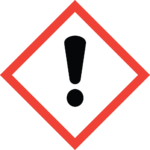
Irritant, dermal sensitizer, acute toxicity (harmful), or respiratory tract irritant 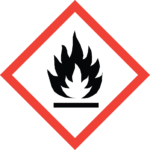
Flammables, self-reactives, or pyrophorics 
Explosives, self-reactives, or organic peroxides 
Gas under pressure 
Carcinogen, reproductive toxicity, or target organ toxicity 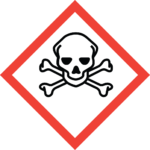
Acute toxicity (severe) 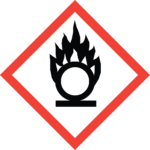
Oxidizers 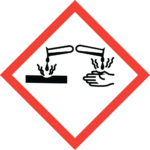
Corrosives 
Environmental toxicity Labeling containers leaving University facilities
Hazardous substances covered under this program (see the Application tab) that leave University facilities shall be labeled as described above.
The excepted quantities training (EHS-2650) provides guidance on labeling requirements for shipping hazardous substances.
More detailed explanations on hazard classification and label requirements for shipping hazardous substances can be found in the Shipping Hazardous Materials section.
Proposition 65 warning notice
Required notification or notices shall be posted, as required by Proposition 65, whenever employees and/or the public are exposed to substances known to the State to cause cancer or reproductive toxicity.
At Stanford, Proposition 65 notices are posted on the cover of the Life Safety Boxes wherever Proposition 65 substances are present (see the Hazardous Chemical Inventory tab).
The most current list of Prop 65 chemicals can be found online.
Unlabeled pipes
Aboveground pipes transporting hazardous substances (e.g. gases, vapors, liquids, semi-liquids, or plastics) shall be labeled in accordance with 8 CCR Section 3321 (“Identification of Piping”).
Employees shall not work on any unlabeled pipe until:
- The contents of the pipe are determined
- Appropriate safety precautions have been determined for the work
The purpose of a safety data sheet (SDS) is to provide health and safety data about a specific hazardous substance. The SDS discloses:
- The chemical composition and properties of the hazardous substance
- Health and physical hazards
- Safe handling, storage, and control methods
- Emergency response and first aid procedures
General requirements
- An SDS shall be available for every hazardous substance used in a work area and shall be accessible to employees.
- The manufacturer/importer/distributor shall provide an SDS with or before the initial shipment of the hazardous substance(s) and with or before the first shipment after an SDS is updated.
- If the SDS is not provided with the shipment, the purchaser (i.e. laboratory or shop supervisor) shall obtain one from the manufacturer, importer, or distributor before using the purchased material.
- SDSs shall be in English and shall contain the information specified on the OSHA Safety Data Sheet site.
- If employees travel between workplaces, SDSs may be kept at a central location (e.g. a shop). However, the required information shall be available in an emergency.
Obtaining SDSs
Supervisors shall ensure that employees can obtain SDSs from the following sources:
- The supervisor
- EH&S
- The reference links section in Chemical Safety
- The Safety Fact Sheet repository in the References section of this site
Stanford University synthesized substances
SDS and labeling requirements apply to hazardous substances synthesized at Stanford University and sent offsite. Contact the EH&S Occupational Health and Safety Program for assistance and further details.
Trade secrets
Manufacturers and importers may withhold the specific chemical identity of a hazardous substance with certain “trade secret” provisions. If information in an SDS is withheld as a “trade secret,” contact EH&S.
General requirements
University laboratories, departments, and shops shall maintain an inventory of hazardous substances present in their areas. At Stanford, inventories must be maintained using ChemTracker 4, the online inventory system provided by EH&S.
Life Safety Boxes (LSBs)
Life Safety Boxes (LSBs), located outside of each room containing hazardous chemicals, provide room-specific chemical hazard information to emergency response personnel.
Hazard labels on the front of the Life Safety Boxes represent the different types of hazards that may be present within the lab. Update your LSB at least annually. Information in the LSBs includes:
- A cover page with hazard symbols representing the different types of hazards within the lab and a guide to hazard quantities (provided annually by EH&S once your chemical inventory is submitted to the state)
- Stanford University’s emergency contact form (or School of Medicine emergency contact form) Emergency Contact Sheets or SOM contact sheets
- Chemical storage map https://ehs.stanford.edu/forms-tools/blank-chemical-storage-map
Notes:
- If no changes are necessary (information is still current), initial and date the existing sheets
- An updated cover page and hazard quantities sheet(s) will be delivered by EH&S at a later date https://ehs.stanford.edu/request-a-life-safety-box-printout
